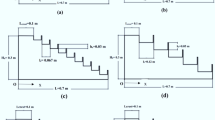Abstract
The free flow on the step surfaces has received much attention for its representative body type, flow structure, water-air two phase flow, cavitation, and many complex issues. The experiments about the time-averaged pressure and aeration concentration distribution on the step surface show that the vertical plane of steps will inevitably experience negative pressure, which must rely on adequate aeration concentration to avoid cavitation damage. However, the self-aerated flow at the head section has a relatively low aeration concentration, and the concentration of the entire steps decreases with the increasing of weir head, the minimum appears in the vicinity of the corner, and the location is close to the minimum pressure. Thus, it is necessary to set aerator in the upstream end of the step surfaces to avoid cavitation damage.
Similar content being viewed by others
References
Zhang Z C H, Zeng D Y, Liu Y F. Experimental investigation on the characteristic of air entrainment on the stepped spillways (in Chinese). Chin J Appl Mech, 2003, 20: 97–100
Huang B, Wang G Y, Zhao Y. Physical and numerical investigation on transient cavitating flows. Sci China Tech Sci, 2013, 56: 2207–2218
Ohtsu I, Yasuda Y, Takahashi M. Discussion of onset of skimming flow on stepped spillways. J Hydraul Eng-Asce, 2001, 127: 522–524
Ohtsu I, Yasuda Y. Characteristics of flow condition on stepped channels. In: Proceeding of 27th IAHR Congress. San Francisco USA Theme D, 1997. 583–588
Sanchez M. Pressure field in skimming flow over a stepped spillways. In: Proceeding Intl. Workshop on Hydraulics of Stepped Spillways, VAW, ETH-Zurich, H.E. Minor and W.H. Hager. Balkema, 2000. 137–145
Matos J, Quintela A. Air entrainment and safety against cavitation damage in stepped spillways over RCC dams. In: Proceeding Intl. Workshop on Hydraulics of Stepped Spillways, VAW, ETH-Zurich, H.E. Minor and W.H. Hager. Balkema, 2000. 69–76
Bindo M, Gautier J, Lacroix F. The stepped spillway of M-Bali dam. Int Water Power Dam Constr, 1993, 45: 35–36
Michaels V, Lovely M. Some prototype observations of air entrained flows. In: Proceedings of Minnesota Conference, IAHR, Minnesota, USA, 1953. 403–414
Wood I R, Ackers P, Loveless J. General method for critical point on spillways. J Hydraul Eng-Asce, 1983, 109: 308–312
Chanson H. Hydraulics of skimming flows over stepped channels and spillways. J Hydraul Res, 1994, 32: 445–460
Chanson. Stepped spillway and air entertainment. J Civil Eng, 1993, 6: 422–435
Hunt S L, Kadavy K C. Inception point relation-ship for flat-sloped stepped spillways. J Hydraul Eng-Asce, 2011, 137: 262–266
Boes R M, Hager W H. Two-phase flow characteristics of stepped spillways. J Hydraul Eng-Asce, 2003, 129: 661–670
Wu J H, Zhang B, Ma F. Inception point of air entrainment over stepped spillways. J Hydrodynamics, 2013, 25: 91–96
Matos J, Quintela A. Discussion about Jet flow on stepped spillways. J Hydraul Eng-Asce, 1995, 121: 443–444
Chamani M R, Rajajratnam N. Discussion about Jet flow on stepped spillways. J Hydraul Eng-Asce, 1995, 121: 446–448
Chanson H. Hydraulic design of stepped spillways and downstream energy dissipations. Dam Engineering, 2001, 11: 235–242.
Ma H B, Fu X D. Stochastic formulation of particle kinetics in wall-bounded two-phase flows. Sci China Tech Sci, 2014, 57: 2001–2011
Felder S, Chanson H. Energy dissipation down a stepped spillway with non-uniform step heights. J Hydraul Eng-Asce, 2011, 137: 1543–1548
Pfister M, Hager W H. Self-entrainment of air on stepped spillways. Int J Multiphas Flow, 2011, 37: 99–107
Pfister M, Hager W H, Minor H E. Stepped chutes: Preaeration and spray reduction. Int J Multiphas Flow, 2006, 32: 269–284
Chen J G, Zhang J M, Xu W L. Practical engineering application and hydraulic characteristics of the flow in stepped spillway with pre-aerator slot (in Chinese). J Sichuan Univ (Engineering Science Edition), 2010, 42: 6–11
Wu J H, Ma F. Cavity flow regime for spillway aerators. Sci China Tech Sci, 2013, 56: 818–823
Han Y W, Qiang H F, Huang Q Z. Improved Implicit SPH Method for simulating free surface flows of power law fluids. Sci China Tech Sci, 2013, 56: 2480–2490
Author information
Authors and Affiliations
Corresponding author
Rights and permissions
About this article
Cite this article
Xu, W., Luo, S., Zheng, Q. et al. Experimental study on pressure and aeration characteristics in stepped chute flows. Sci. China Technol. Sci. 58, 720–726 (2015). https://doi.org/10.1007/s11431-015-5783-6
Received:
Accepted:
Published:
Issue Date:
DOI: https://doi.org/10.1007/s11431-015-5783-6




